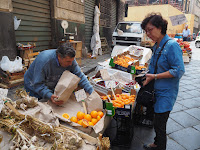Our return flight by Swiss Air from Florence to Singapore on 26 May 2018 has a transit stopover in Zurich. Soon after our flight landed at Zurich International Airport at about 3.30pm, we decided to spend a couple of hours in Zurich city before proceeding our flight back to Singapore. We took a train straight from the airport to the main train station in Zurich.


Zurich knows how to promote the city. Upon arrival at the airport, visitors are greeted by Roger Federer in "person".
With limited time, we could only do a walking tour around the old city from the main train station. The city, as least the part we visited is cyclists and pedestrian friendly. We only saw public transport and very minimal private vehicles plying the road.









Fraumunster Church


Left: A typical lane in old City.
Right: Grossmunster
Our tour ended with wine and pizza at a roadside restaurant. The pizza is thin and crispy and topped with truffle. While enjoying the passerby and ambiance, we were also entertained by a group of buskers.






































































